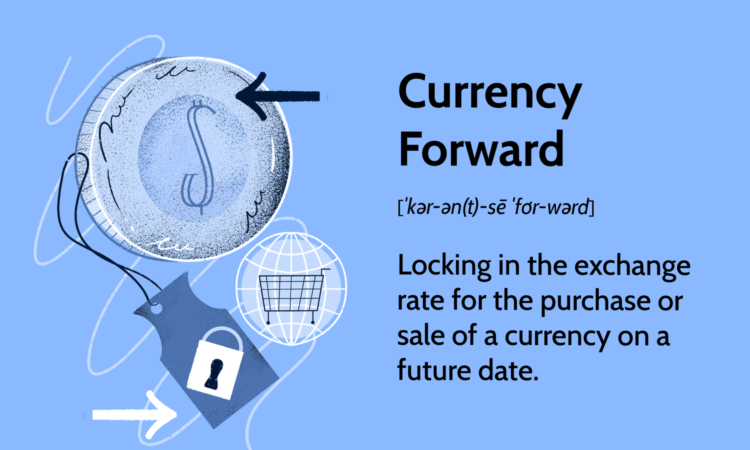
What Is a Currency Forward?
A currency forward is a binding contract in the foreign exchange market that locks in the exchange rate for the purchase or sale of a currency on a future date. A currency forward is essentially a customizable hedging tool that does not involve an upfront margin payment.
The other major benefit of a currency forward is that its terms are not standardized and can be tailored to a particular amount and for any maturity or delivery period, unlike exchange-traded currency futures.
Key Takeaways
- Currency forwards are OTC contracts traded in forex markets that lock in an exchange rate for a currency pair.
- They are generally used for hedging, and can have customized terms, such as a particular notional amount or delivery period.
- Unlike listed currency futures and options contracts, currency forwards do not require up-front payments when used by large corporations and banks.
- Determining a currency forward rate depends on interest rate differentials for the currency pair in question.
Investopedia / Michela Buttignol
Understanding Currency Forwards
Unlike other hedging mechanisms such as currency futures and options contracts—which require an upfront payment for margin requirements and premium payments, respectively—currency forwards typically do not require an upfront payment when used by large corporations and banks.
However, a currency forward has little flexibility and represents a binding obligation, which means that the contract buyer or seller cannot walk away if the “locked-in” rate eventually proves to be adverse. Therefore, to compensate for the risk of non-delivery or non-settlement, financial institutions that deal in currency forwards may require a deposit from retail investors or smaller firms with whom they do not have a business relationship.
Currency forward settlement can either be on a cash or a delivery basis, provided that the option is mutually acceptable and has been specified beforehand in the contract. Currency forwards are over-the-counter (OTC) instruments, as they do not trade on a centralized exchange, and are also known as “outright forwards.”
Importers and exporters generally use currency forwards to hedge against fluctuations in exchange rates.
Example of a Currency Forward
The mechanism for computing a currency forward rate is straightforward, and depends on interest rate differentials for the currency pair (assuming both currencies are freely traded on the forex market).
For example, assume a current spot rate for the Canadian dollar of US$1 = C$1.0500, a one-year interest rate for Canadian dollars of 3 percent, and the one-year interest rate for US dollars of 1.5 percent.
After one year, based on interest rate parity, US$1 plus interest at 1.5 percent would be equivalent to C$1.0500 plus interest at 3 percent, meaning:
- $1 (1 + 0.015) = C$1.0500 x (1 + 0.03)
- US$1.015 = C$1.0815, or US$1 = C$1.0655
The one-year forward rate in this instance is thus US$ = C$1.0655. Note that because the Canadian dollar has a higher interest rate than the US dollar, it trades at a forward discount to the greenback. As well, the actual spot rate of the Canadian dollar one year from now has no correlation on the one-year forward rate at present.
The currency forward rate is merely based on interest rate differentials and does not incorporate investors’ expectations of where the actual exchange rate may be in the future.
Currency Forwards and Hedging
How does a currency forward work as a hedging mechanism? Assume a Canadian export company is selling US$1 million worth of goods to a U.S. company and expects to receive the export proceeds a year from now. The exporter is concerned that the Canadian dollar may have strengthened from its current rate (of 1.0500) a year from now, which means that it would receive fewer Canadian dollars per US dollar. The Canadian exporter, therefore, enters into a forward contract to sell $1 million a year from now at the forward rate of US$1 = C$1.0655.
If a year from now, the spot rate is US$1 = C$1.0300—which means that the C$ has appreciated as the exporter had anticipated – by locking in the forward rate, the exporter has benefited to the tune of C$35,500 (by selling the US$1 million at C$1.0655, rather than at the spot rate of C$1.0300). On the other hand, if the spot rate a year from now is C$1.0800 (i.e. the Canadian dollar weakened contrary to the exporter’s expectations), the exporter has a notional loss of C$14,500.
What Is the Difference Between Currency Forwards and Currency Futures?
Currency forwards and futures are very similar. The main difference is that currency futures have standardized terms and are traded on exchanges such as the Chicago Mercantile Exchange (CME), whereas forwards have customizable terms and are traded over-the-counter (OTC).
Why Are Currency Forwards Used?
Currency forwards are used to lock in an exchange rate for a certain period of time. This is often used to hedge foreign currency exposure
Which Currencies Can Currency Forwards Be Written on?
Because they are customizable and trade OTC, currency forwards can appear on any number of currency pairs. Which ones would be determined by the counterparties involved in the trade.


